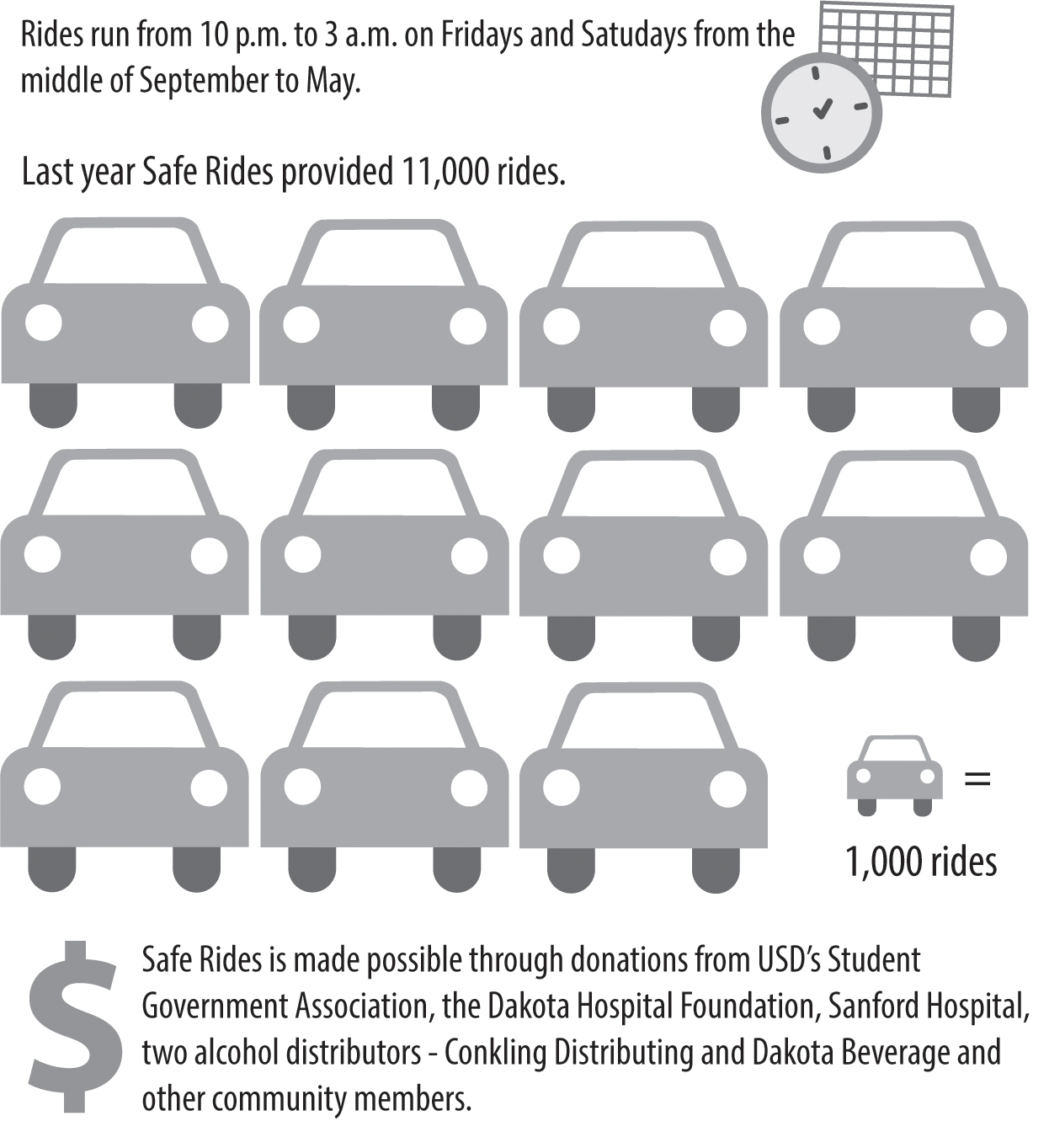
Safe Rides faces budget cut, schedule changes
The Safe Rides program had to drop a day out of their pick-ups this year due to a budget cut.
Safe Rides is a free transportation service that takes students home after a night of drinking. The Safe Rides bus runs from 10 p.m. to 3 a.m. on Fridays and Saturdays.
“It acts as a taxi service until about 1 a.m.,” said Michele Turner, prevention coordinator and counselor at the Student Counseling Center. “At 1 a.m., they will go down Main Street and pick up as many people as they can that are coming out of the bars when they’re closing to take them home.”
Safe Rides is funded in part by a grant from the South Dakota Highway Safety, which has to be matched by 50 percent. Turner said funds are matched by the Student Government Association, the Dakota Hospital Foundation, Sanford Hospital, two alcohol distributors — Conkling Distributing and Dakota Beverage — and some local community members.
Turner said a portion of the South Dakota Highway Safety has been cut, which means they had to change the schedule.
“I know that we’re not the only ones affected by the cut — about 48 percent of people being funded were cut,” she said. “Now (the bus) will only be running starting Sept. 15 on Friday and Saturday nights. It used to include Thursday nights, but we had to cut out a day.”
Safe Rides started as a pilot program about 11 years ago.
“It did so well that it became an annual thing,” Turner said. “Its purpose is to prevent people who have chosen to drink from getting behind the wheel.”
Morgan Jarding, a senior social work major, said the program is an important one. Jarding said she’s ridden on the bus “many times.”
“If you’re trying to go from downtown to somewhere far away, it’s really nice,” Jarding said. “It keeps you safe at all times.”
Turner also said this program has other positive “side effects.”
“We’ve seen a decrease in other things like sexual assaults and loitering and public urination and vandalism,” she said. “It’s a vehicle to help people be safe. We average 10,000 rides in that time frame. This last year was over 11,000 rides, so we’ve seen an increase.”
Heath Larson, vice president of Conkling Distributing, said the company decided to donate to Safe Rides because it was the right thing to do.
“It gives the kids out on town a safe ride home,” Larson said. “The last thing we want is someone in an accident to face consequences (for) a bad
decision.”
Larson, a USD alumnus, said Safe Rides is important for college students.
“I think that the value this brings to the community allows people to have a good time, and at the end of the night, this allows them to make the right decision to get a ride home,” Larson said. “The program brings value not only to students, but the community as a whole.”
With only two days of rides, Turner said it’ll be “interesting” to see how numbers are affected.
“Thursdays were our slowest shifts,” she said. “Our biggest numbers are definitely on Friday and Saturday nights, so we kept the ones that had the most impact. Will we see a decrease in ridership? I don’t know.”
Though the fund was cut, there are other changes in the works that Turner said she’s excited for.
“In a few weeks, we’re trying to purchase some software that people can download an app, called ‘Tap Right,’” Turner said. “They’ll download an app and they’ll be able to see where the bus is in real time, and they’ll be able to call the bus from the app and put the address of where they are and where they’re trying to go, and I think that’s going to increase our service as well as streamline the process.”
Taylor Jones, a sophomore psychology major, said Safe Rides keeps the community safe.
“I think it’s really important so people aren’t driving drunk,” she said.
If Safe Rides funding continues to see cuts, its future is unknown, Turner said.
“The community needs to decide that it’s worth it, and we need to go from there,” she said.
Turner said the importance of Safe Rides “comes down to people making choices.”
“If you’re making the choice to drink, making the choice to use Safe Rides instead of getting behind the wheel — that is a good choice,” she said. “When I think about how many annual rides we give, 10,000, 11,000 rides a year, that’s 11,000 good choices people made, and that makes me excited.”


